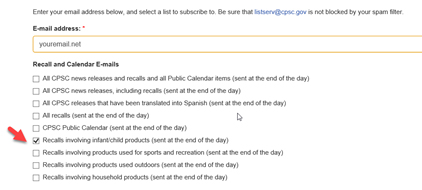
Wisconsin Department of Children and Families - Division of Early Care and Education
Bureau of Early Care Regulation
Child Care Certification Policy Manual
DCF 202.08(11)(a) Each child shall be allowed to have undisturbed rest or a nap, when needed, in a place that is clean, safe and comfortable.
DCF 202.08(11)(c) To reduce the risk of sudden infant death syndrome, each infant shall be placed to sleep on his or her back, unless otherwise directed by the child's physician. All sleeping arrangements for children under one year of age shall use firm mattresses.
DCF 202.08(11)(d) A safe crib or playpen with a tight fitting mattress with a tight-fitting covering shall be available for each child under one year of age to use for napping or sleeping. The crib or playpen may not contain soft or loose materials, such as sheepskins, pillows, blankets, flat sheets, bumper pads, bibs, pacifiers with attached soft objects or stuffed animals. A certified family child care operator shall ensure that each crib used by a child in care satisfies the applicable federal safety standards in 16 CFR Part 1219 or 1220.
The Consumer Products Safety Commission (CPSC) published new standards for cribs intended to improve safety. Beginning December 28, 2012, all cribs provided by a child care program must meet new federal safety standards. The standards took effect for manufacturers, retailers, importers and distributors on June 28, 2011. The standards apply to all full-size, non full-size cribs including wood, metal and stackable cribs. Portable cribs and playpens that have mesh or fabric sides are not subject to the new standards. Beginning December 28, 2012, licensing and certification staff are to monitor programs for compliance with this requirement. Programs will be required to provide documentation that all wood, metal or stackable cribs comply with the new crib standards. This documentation could consist of a certificate of compliance from the manufacturer or a label attached to the crib indicating that date of manufacture was June 28, 2011 or later.
Note: A crib that was manufactured or sold before June 28, 2011, may not satisfy the crib safety standards in 16 CFR 1219 or 1220.
Crib Standards
A Safer Generation of Cribs - US Consumer Product Safety Commission
Bare is Best - Tips to keep babies safely sleeping - US Consumer Product Safety Commission
It is recommended certification workers complete an in-person SIDS training in their area to learn more about safe sleep environments and SIDS reduction. SIDS training is aimed to promote the health and safety of infants in child care settings by providing education and outreach to child care providers regarding safe sleep recommendations and because certification workers will be evaluating safe sleep environments, it will be helpful to learn more about this topic.
DCF 202.08 (8m) definition of hazard includes recalled products.
DCF 202.08 (11) (a) Each child shall be allowed to have undisturbed rest or a nap, when needed, in a place that is clean, safe and comfortable.
It is important certification workers and operators are made aware of the fairly new crib standards and information regarding recalled products, including specific portable cribs.
Consumer Product Safety Commission Subscription

Weighted Sleep Sacks
The excerpt below was taken from a DECE listserv communication in October 2022 regarding the use of weighted swaddles and weighted sleep sacks.
The National Center on Early Childhood Quality Assurance hosted a Safe Sleep webinar on September 29, 2022. Dr. Rachel Moon, Pediatrician and Chair of the American Academy of Pediatrics Task Force on SIDS, shared 2022 Updated Safe Infant Sleep Guidelines. The webinar covered:
Why infants die in their sleep
New Federal Safety Standards for Sleep Surfaces and Consumer Product Safety Commission Final Rule for sleep products for infants 5 months and younger
2022 changes in safe sleep guidelines
Did you know that weighted swaddles and weighted sleep sacks are not recommended? See slide 43+ in the webinar recording.
Although the webinar discusses alternative sleep surfaces, keep in mind DCF licensing and certification safe sleep rules for infants require:
Each child under one year of age shall be placed to sleep on his or her back in a crib unless otherwise specified in writing by the child’s physician.
A child under one year of age may not sleep in a crib or playpen that contains soft or loose materials, such as sheepskins, pillows, blankets, flat sheets, bumper pads, bibs, pacifiers with attached soft objects, or stuffed animals. No blankets or other items may be hung on the sides of a crib or playpen.
Cribs and playpens shall contain a tight-fitting mattress and any mattress covering shall fit snugly over the mattress.
If you missed the webinar, you can view the recording. Contact your licensing specialist or certification worker if you have questions regarding safe sleep for infants.
This page last updated 11/2023.